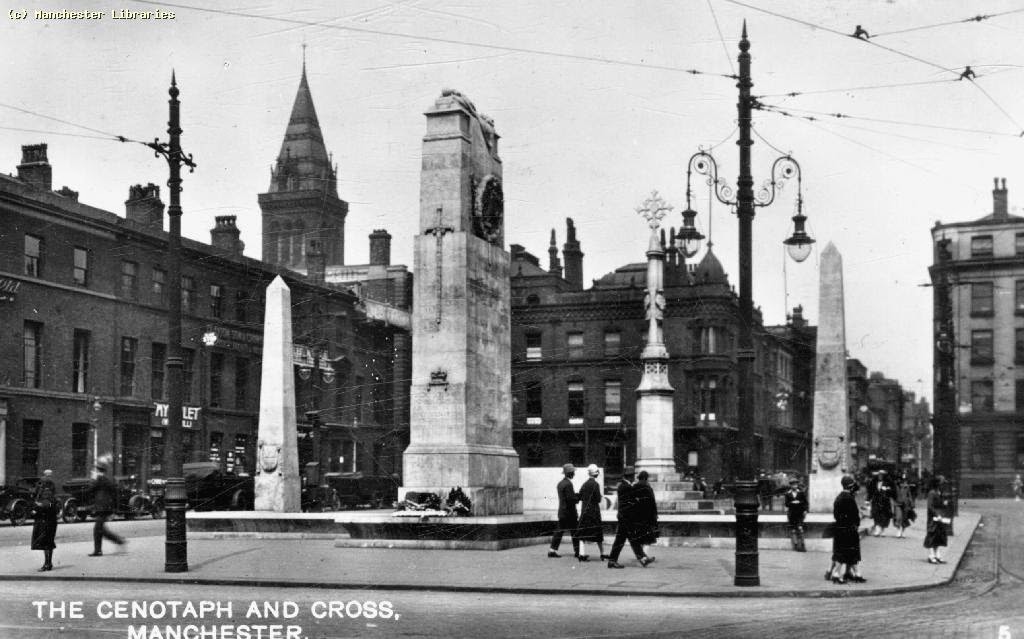 |
| The Cenotaph, 1925 |
‘The victorious nation pays as much as the vanquished in the loss of the flower of its population and there are many broken hearts in the conquering country as there are in the conquered.’
The same idea was uppermost in the character of the ceremony itself. Mrs Bingle, a citizen of the working class district of Ardwick, whose three sons had been killed in the war assisted Lord Derby with the unveiling”*
All of which I think was a fitting tribute to those who died and to the families left to bear the loss.
Now both of those invited that day to unveil our war memorial are interesting. Lord Derby had been closely associated with recruiting men for the war and will forever be linked with the Pals battalions which “should be a battalion of pals, a battalion in which friends from the same office will fight shoulder to shoulder for the honour of Britain."**
 |
| Rylance Street, 1964 |
The family were not from Manchester, they came from Stroud in Gloucestershire but had settled in the eastern side of the city by 1899, and in the years before the Great War never seemed to stray far from Rylance Street just off the Ashton Old Road.
Here they brought up eight children in houses ranging in size from 3 rooms up to five. Mr Bingle was engaged in making umbrellas, their eldest son was a career soldier, another a postman and their youngest son an errand boy.
It was an area of densely packed terraced housing, dominated by the railway depot to the south and surrounded by iron and steel works, the Bradford Colliery and countless smaller enterprises.
In time I will I hope be able to track the lives of Albert and Frances Bingle and their eight surviving children.
 |
| The Statue on the "war stone", 1992 |
History has been capricious with the details of their military careers and so all we know of their eldest son was that he had enlisted by the time he was 18 in 1901 and at his death had reached the rank of sergeant.
His brother Charles Henry was a gunner and Nelson Allen the youngest of the three was a 2nd Corporal in the Royal Engineers.
That said some of Nelson’s army records have survived and I know that he signed up at Ardwick in the April of 1915 aged 19.
It is so little for what amounted to such a great sacrifice and the enormity of that loss must have been overwhelming, more so because all three died in the final year of the war.
Nelson aged 21 was killed in the March, Ernest Albert the oldest on May 8th and Charles Henry on the 27th.
 |
| At the Cenotaph, 1942 |
And that I think this is the moment to close.
But I will return to the story not least to describe the day of the unveiling in more detail perhaps when the Cenotaph is rededicated in its new position in front of the west door of the Town Hall.
And that will also be an appropriate moment to explore the lives of the Bingle family in more detail.
Pictures; The Cenotaph and Cross, St Peter’s Square, Manchester 1925, m52055, Rylance Street where the family were living in 1911, Taken by T Brooks in 1964, m12974, Statue on top of the Cenotaph, St Peter's Square, Manchester Mark Cobley, 1992 m80515, and a service at the Cenotaph in 1942, G Hinks, m09818, courtesy of Manchester Libraries, Information and Archives, Manchester City Council, http://images.manchester.gov.uk/index.php?session=pass
*The Manchester Guardian, July 14, 1924
**Lord Derby speaking in Liverpool in August 1914. The idea had actually been suggested a few days earlier by General Sir Henry Rawlinson that men would be more inclined to enlist in the Army if they knew that they were going to serve alongside their friends and work colleagues.
He had appealed to London stockbrokers to raise a battalion of men from workers in the City of London to set an example. 1,600 men enlisted in this 10th (Service) Battalion, Royal Fusiliers, the so-called "Stockbrokers' Battalion", within a week in late August 1914.
***ibid The Manchester Guardian, July 14, 1924
Suggested by a story, The Cenotaph is Moving by Ann Beswick, March 17 2014, http://www.manchesterguidedtours.com/blog-news
No comments:
Post a Comment